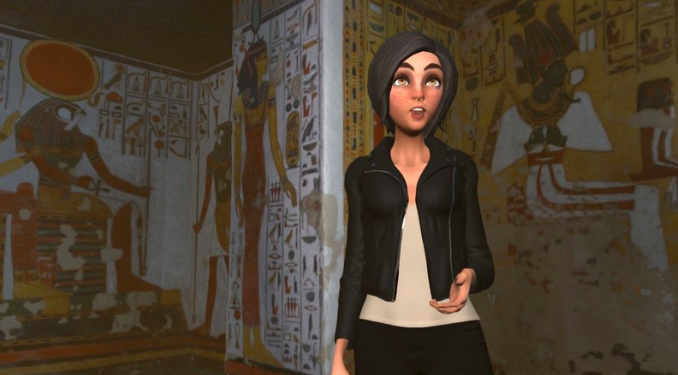
High Fidelity Raises $35M to Bring Social VR to 1 Billion People
High Fidelity, the open-source distributed VR platform, today announced $35 million in Series D funding to continue development of a global infrastructure for VR experiences. Blockchain investment firm Galaxy Digital Ventures led the round, investing $20 million from its Galaxy EOS Ecosystem Fund, with additional new investors including Blockchain Capital. Existing investors also participated, including Breyer Capital, IDG Capital Partners and Vulcan Capital.
The latest round brings total investment in High Fidelity to more than $70 million. High Fidelity will use the funds to expand R&D, accelerate hiring and open a new office in Seattle.
“Virtual reality may be the first killer app for blockchain. It’s a global phenomenon that fundamentally requires a trustless consensus mechanism for currency, property and identity,” said Sam Englebardt, a founding partner of Galaxy Digital Ventures, who joins the board of High Fidelity alongside the investment. “That’s what the new generation of blockchain protocols like EOS enable, and High Fidelity has the vision, team and open platform to lead the worldwide transition from atoms to bits.”
As the founder of Second Life, High Fidelity CEO and co-founder Philip Rosedale created and oversaw the growth of the first mainstream virtual world and digital currency, which has produced over $4 billion globally in virtual transactions.
Over the coming decade, High Fidelity foresees VR growing to Internet scale, reaching 1 billion people and generating a $1 trillion economy of virtual goods and services through the entrepreneurial creation of experiences including entertainment, education, employment and virtual travel. As the VR economy grows, High Fidelity will draw revenues from currency growth, marketplace transactions and other global services.
High Fidelity has already developed the technology to bring VR to a mass audience, including:
The High Fidelity VR software platform, which powers immersive 3D experiences, with ultra-high resolution environments, realistic avatars and imperceptible end-to-end latency, allowing natural interaction between people. Low-latency, high-fidelity 3D audio for voice, effects and music creates a convincing sense of presence. A full-body inverse kinematics (IK) system and support for full-motion capture offers realistic, real-time avatar movement within VR. Scalable to large crowds, the platform offers support for hundreds of people together in a single VR experience on a single server. It is fully extensible, allowing integration of third-party applications and hardware. High Fidelity can be self-hosted or deployed on public clouds such as Digital Ocean.
High Fidelity Coin (HFC), a high-speed “stablecoin” cryptocurrency designed specifically for commerce, usable anywhere in the world, offering near-instantaneous transaction speeds and low transaction costs.
High Fidelity’s Digital Asset Registry, based on the blockchain, providing indisputable proof of identity and ownership and strong protection against content forgery. The registry allows users to control which elements of their identity to reveal to third parties, and its decentralized nature puts it outside the control of a single organization and back into the user’s hands.
The High Fidelity Marketplace, which allows users to buy and sell objects such as avatars, clothing and equipment, as well as scripts and applications to extend the VR experience.
Javascript-based, multi-user creator tools that allow developers to design and build environments and objects directly within High Fidelity. High Fidelity’s platform also enables the development of code scripts to animate and automate actions within VR. Creators can import existing 3D objects generated in common 3D modeling or CAD tools.
The founding of the Virtual Reality Blockchain Alliance, which is defining the protocols for global interoperability in VR. The Virtual Reality Blockchain Alliance (VRBA) is a consortium of organizations working to enable people, their property and their money to move freely between virtual worlds. Current members include Admix, BLOCKv, High Fidelity, JanusVR, Somnium Space and SVVR.
“We will go to school, attend events, entertain each other, and build entirely new worlds together, all from within VR,” said Philip Rosedale, CEO and founder of High Fidelity. “To reach this scale and to deliver safely on such a promise, VR must be decentralized, including deeply using blockchain technology. Galaxy Digital will guide us capably in adopting that technology and creating the right partnerships with the larger blockchain ecosystem, for example the EOS blockchain where we are currently beta testing integration.”
High Fidelity has been rapidly developing a powerful software platform for delivering social VR experiences, with hundreds of open source developer contributors and thousands of alpha and beta users developing hundreds of servers with exploratory content and location-based VR providers. These demonstrate the ability of VR to create a shared, open, interactive experience bringing people from around the world together to learn, work, exchange ideas, express their creativity and have fun.
Sample experiences include:
Nefertari: Journey to Eternity by CuriosityStream — students and adults enter an Egyptian tomb captured in 3D for a guided tour led by an Egyptologist.
Speaker Series — join the audience in an auditorium for discussions with prominent thought leaders.
RUST — a nightclub with live performances from DJs and an audience of people from around the world.
